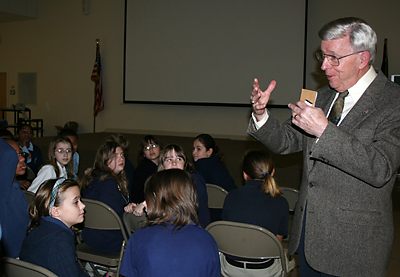
 SUMTER—Gene Austin brought students at St. Anne School closer to the stars recently.
SUMTER—Gene Austin brought students at St. Anne School closer to the stars recently.
Austin, a retired NASA official from Alabama, gave a presentation Feb. 3 to students in fifth through eighth grades about the wonders of space, and how science and math play a key role in astronomy.
The students saw videos and a PowerPoint presentation and discussed everything from new space vehicles to the Kuiper belt, the size of the Milky Way, black holes and efforts to detect life in the universe.
His visit was the result of months of work and communication with math teacher Vanya Hines and her students.
“This all evolved to get the students more interested in math,” Hines said. “We wanted to get these kids excited about doing well in math as early as possible, because standardized tests showed it was something we needed to work on.”
Hines started assigning students projects to show how math applies in a wide variety of career fields. Then she heard about Austin and his work through Allison Austin, who teaches science at St. Anne. Gene Austin is her husband’s uncle.
Hines’ students came up with questions about space and space travel and e-mailed them to Austin. Initially he was just going to answer them through e-mail and talk to students via videoconference, but he said their questions were so good he decided to come to the school.
Austin worked for NASA for 42 years, much of the time based at the Marshall Space Flight Center in Huntsville. His assignments included stints as director of the Space Transportation and Exploration Office, and deputy director of the Advanced Transportation Technologies Office. He worked extensively on developing new space transportation technologies, including the X-33 program, a partnership between NASA and industry to develop a reusable launch vehicle.
After he retired, he and his wife Judith started GJ Systems, Inc., which offers consulting and seminars about space transportation. Recently, he has worked with NASA on programs such as the Human Mars Mission and the ARES Launch Vehicle.
Austin showed the students beautiful photos taken by the Hubble Space Telescope and talked about recent competition among private citizens working to develop space vehicles, including a plane that can take people into orbit.
He told them it was important to work hard in all subjects, but that science and math were especially crucial to any work in astronomy and other space sciences. He also showed slides of famous scientists and physicists, and reminded them that Albert Einstein did not particularly enjoy studying math when he was a young man.
“He managed to help the kids understand the importance of the fundamentals of math, but also showed the magic of space,” Allison Austin said. “They learned there are still mysteries and that it hasn’t all been answered yet.”
After the talk, students were eager to discuss the new things they learned. They were especially intrigued by the theory that extensive space travel will cause people to age more slowly than they do on Earth.
Austin said he was impressed with the depth and range of the students’ questions and their interest.
“Encouraging elementary and middle school kids in their interests and encouraging them to study science and math is something I feel very strongly about,” he said.
